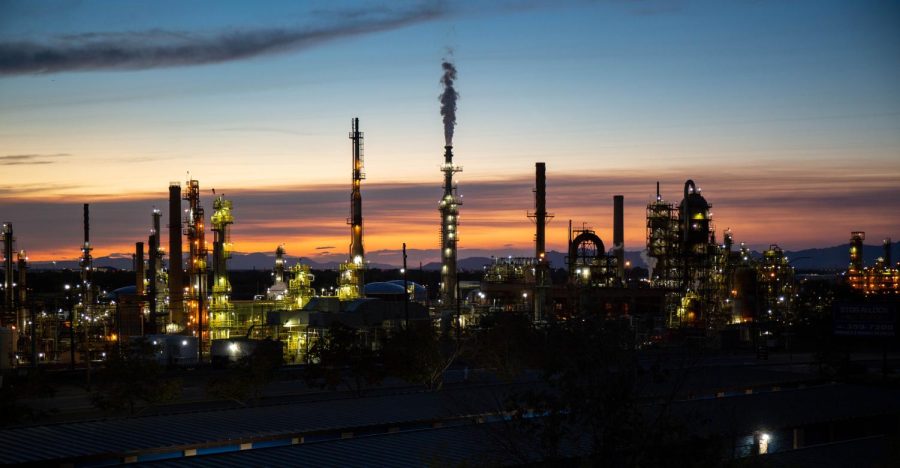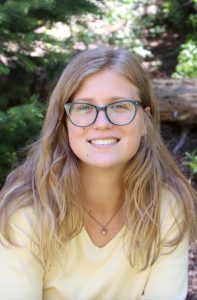Lezaic: Don’t Abandon the West Side
Marathon Petroleum Corporation’s Salt Lake City Refinery in Northern Salt Lake City on Oct. 4, 2021. (Photo by Gwen Christopherson | The Daily Utah Chronicle)
November 9, 2022
Having grown up next to the Jordan river, I’m familiar with the smell of polluted water. I went to a school where, on the other side of the fence at recess, farmers burned horse and cow manure. When my parents took me on walks, we strolled past railroad tracks and various industrial plants.
To those who grew up on the east side of Salt Lake, this may sound unusual. But to those who also grew up on the west side, these anecdotes probably sound familiar. Considering that the west side houses the largest percentage of people of color and working-class immigrants in the state, it’s clear that environmental racism creates these disparities.
Defining Environmental Racism in the West Side
Broadly speaking, environmental racism is the disproportionate distribution of environmental hazards to communities of color. The racial demographic of an area is the biggest indicator of how polluted the region will be. People of color comprise 53% of West Valley City’s population, compared to making up 27.9% of the state-wide population. The west side of Salt Lake County also contains the “largest concentration of hazardous waste sites,” according to the Salt Lake Tribune.
This is no coincidence. “The west side, historically, is a redlined area,”said HEAL Utah Communication Director Meisei Gonzalez. And because businesses and the government “purposely weren’t allowing Black, Brown and Indigenous communities to take out mortgages and homes on the east side, they put them towards the west side, which was deemed a hazardous area.”
Racist policies like redlining forced residents of color, primarily Latine residents, to live alongside industries that pollute far more than those in the rest of the region. At the same time, they actively prioritized white LDS families. You can see for yourself — just drive across State Street and the contrast in the environment becomes stark. On the west side, you have sparse trees and bland concrete industrial buildings. Mines, railroads and farms litter the landscape. On the east side, ivy climbs up the walls of gorgeous brick buildings, law firms sit on every corner and lush community gardens decorate the streets.
Environmental Racism on Health
The difference in environment creates dangerous health inequalities. Oil refineries, interstate-produced smog, rail yards and subsequently generated diesel fumes take a toll on west side residents. These influences have ensured worse air quality for the west side. For example, Rose Park has twice the concentration of CO2 compared to our campus and the surrounding area.
Utah’s heavily contested plans for a new inland port also stand to worsen air pollution for west side communities. According to University of Utah Ph.D. candidate and researcher, Casey Mullen, “It’s being developed in a part of town that is already burdened by worse particulate matter air pollution on average annually.” It also “happens to be home to more racially and ethnically diverse folks in comparison to other parts of the valley. The development of this project and the business that it will generate are going to inevitably exacerbate these types of unequal exposures and environmental injustices.”
Industries have already used west side water sources like the Jordan River to drain run-off and sewage since the colonial settlement of the valley. Meanwhile, the government developed the west’s sewage systems last, contributing to its reputation as one of the dirtiest cities in the country. Now, chemicals and dust blow into the west side from the Great Salt Lake as it dries up from industrial exploitation.
These phenomena underscore the disproportionate impacts on west side health. This includes “heart attacks, strokes, Alzheimer’s, cancer, most lung diseases, birth defects, miscarriages, stillbirths, pregnancy complications, Type II diabetes, arthritis, pneumonia and virtually all types of infections.”
U professor Dr. Sara Grineski reiterates, “Our research on patterns of environmental injustice in Salt Lake show dramatic injustices for people of color in terms of exposures to air pollution. When you look at the maps of PM2.5, you can clearly see the east-west pattern, with air quality being worse on the west side of the metro. So, clearly, we need to prioritize improving air quality on the west side.”
Listen to West Side Communities
We’re tired of so-called experts giving us temporary solutions on how to protect our health. Advice to work out in the mornings, stay indoors during inversion, etc. may not be feasible for west side families who often work in toxic conditions. They may not have the privilege of choosing how they interact with their environment.
Gonzalez said solutions come from listening to the community itself. “Education is a really good step to inform yourself … and this can be through storytelling, through different avenues of just being in the community … I think a lot of times there’s this savior mentality in environmentalism where maybe an east side community member thinks they have a solution to the west side, but they don’t know anything that’s going on in the west side.”
Mullen added, “Ensuring that the voices of community members are heard is incredibly important, and all relevant information and conversations should be multi-lingual so as to decrease language barriers and enhance accessibility … The key here is maintaining reciprocal relationships between academics and community members … Academics provide expertise in their own way, while community members provide experiential knowledge and understanding in an equally meaningful way; collaboration between the two is capable of strengthening our approach to addressing environmental injustices, particularly at the local level.”
To accomplish all of this, we need solidarity from the east side on every issue of social justice. As Gonzalez puts it, environmentalism is connected to matters such as immigration, incarceration and police brutality. “Without environmental justice, there’s not going to be different social justices,” he said. “We’re never going to get to a point where the environment is fully protected if we still have all these other issues going on,”
To best protect our environment and people, Utah must look to its most hurt communities for guidance.









